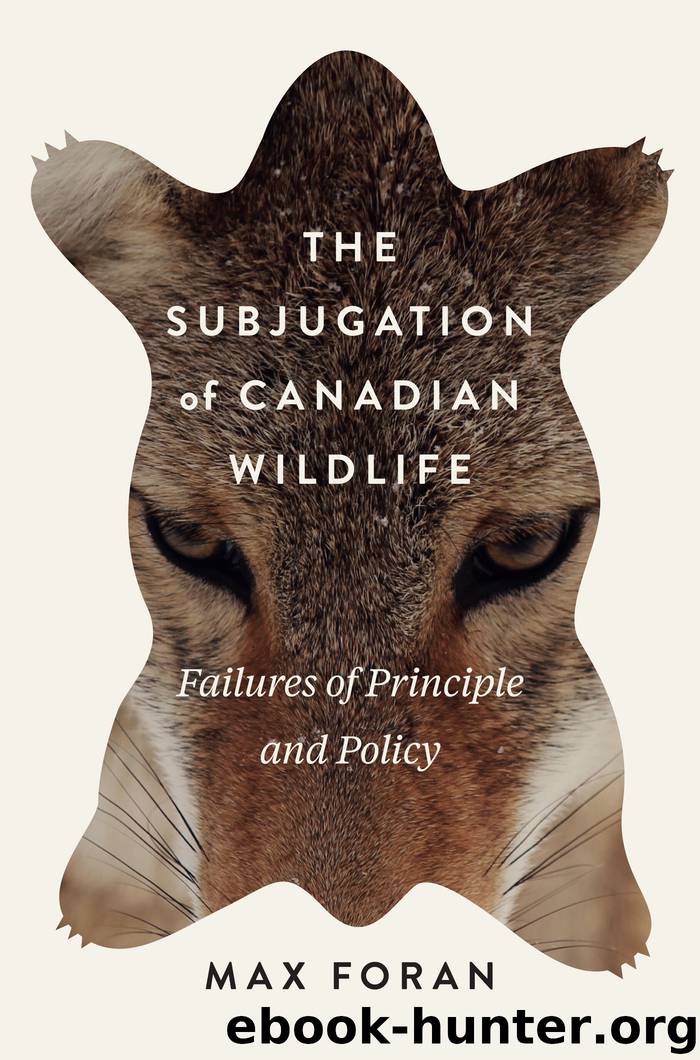The Subjugation of Canadian Wildlife by Max Foran

Author:Max Foran
Language: eng
Format: epub
Publisher: MQUP
Published: 2018-05-12T04:00:00+00:00
The Woodland Caribou
Caribou are another inhabitant of boreal regions and have become synonymous with Canada’s northern environments. Also known as reindeer in North America, they are the only member of the deer family whose males and females both grow antlers. Uniquely adapted to the harsh northern climate, caribou are insulated from the cold by semi-hollow hair that traps warm air next to their skin. Their large crescent-shaped hooves spread when they walk to function like snowshoes or paddles, depending on terrain. An indicator species, these historically symbolic animals are found in three subspecies, the barren-ground, Peary, and woodland. All have listings under COSEWIC and SARA.117 The former two occupy more northerly ranges, whereas the woodland caribou are located farther south and are found in every Canadian province, except New Brunswick and Prince Edward Island.
The precarious state of Canada’s woodland caribou is a prime example of the impact of anthropogenic disruptions to habitat. They are a medium-sized member of the deer family and rich brown in colour with white necks. Unlike the great herds of barren-ground caribou to the north, woodland caribou are usually found in groups of only ten to twenty-five animals. They comprise four populations, all of which are listed under COSEWIC and SARA.118
That the woodland caribou is a threatened species destined for probable extirpation is bad enough. That this seems to be accepted in official circles is worse. Minister of Environment Peter Kent, for example, chose to ignore a court recommendation in 2012 directing him to revisit his decision not to issue an emergency order to protect Alberta’s critically endangered caribou herds from extirpation. He believed that woodland caribou numbers were not threatened overall in Canada, or as he stated, “While there are threats to the recovery of certain populations, there is still sufficient time to take management actions that would achieve recovery objectives.”119 As for Alberta, the parlous state of Alberta woodland caribou was apparently not of particular relevance to the man responsible for the protection of the nation’s fauna.
Woodland caribou are classified into several populations in Canada, the largest of which is the boreal. The following discussion focuses primarily on boreal caribou but is applicable to woodland caribou generally. Around 34,000 boreal caribou are listed as “threatened” under the Species at Risk Act and, although not listed as such, are actually endangered in Alberta. They are not listed in either the Northwest Territories or the Yukon. Boreal caribou require continuous tracts of undisturbed, mature coniferous forests, peat lands, and hilly areas that allow them to disperse widely and maintain low population densities in order to reduce predation risk. Like all woodland caribou, boreal caribou are extremely sensitive to habitat loss, primarily because of their specialized winter diet, which consists almost entirely of lichen in old-growth forest stands. Since no other large mammal can survive on this food source, they live in habitat that separates them from other deer and from their predators. Across Canada, boreal caribou live in fifty-one ranges. At the present time, only fourteen are classified as self-sustaining.
Download
This site does not store any files on its server. We only index and link to content provided by other sites. Please contact the content providers to delete copyright contents if any and email us, we'll remove relevant links or contents immediately.
The Lonely City by Olivia Laing(4568)
Animal Frequency by Melissa Alvarez(4150)
All Creatures Great and Small by James Herriot(3986)
Walking by Henry David Thoreau(3681)
Exit West by Mohsin Hamid(3634)
Origin Story: A Big History of Everything by David Christian(3472)
COSMOS by Carl Sagan(3346)
How to Read Water: Clues and Patterns from Puddles to the Sea (Natural Navigation) by Tristan Gooley(3239)
Hedgerow by John Wright(3106)
How to Do Nothing by Jenny Odell(3101)
The Inner Life of Animals by Peter Wohlleben(3099)
How to Read Nature by Tristan Gooley(3077)
Project Animal Farm: An Accidental Journey into the Secret World of Farming and the Truth About Our Food by Sonia Faruqi(3018)
Origin Story by David Christian(2991)
Water by Ian Miller(2950)
A Forest Journey by John Perlin(2915)
The Plant Messiah by Carlos Magdalena(2745)
A Wilder Time by William E. Glassley(2689)
Forests: A Very Short Introduction by Jaboury Ghazoul(2671)
